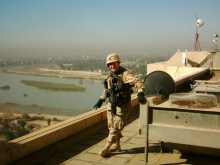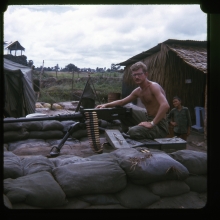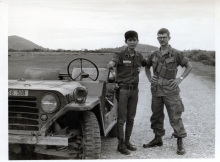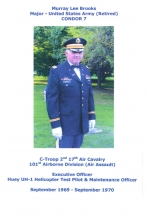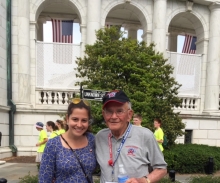Veterans: Share Your Story
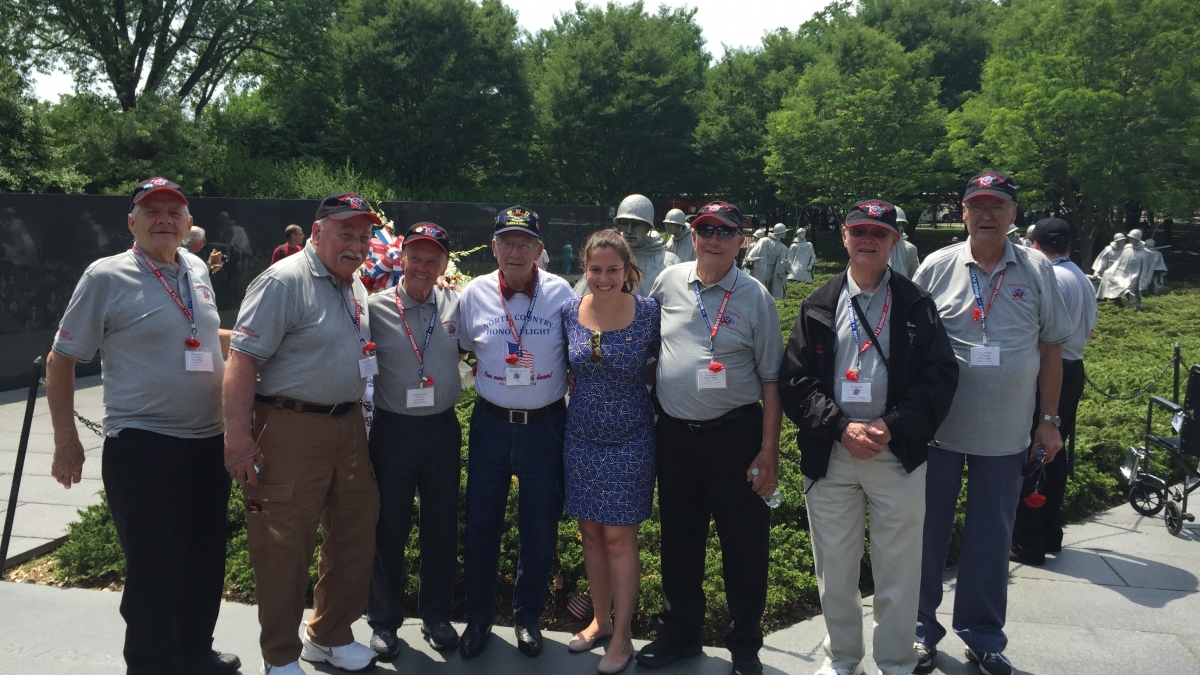
It is a privilege to represent New York's 21st District, the North Country has been home to some of the bravest patriots this country has ever known. Our military service members have sacrificed so much to keep our nation safe, and I am honored to serve these brave veterans in Congress. Throughout the month of November, as a tribute to North Country veterans, I will be sharing their stories with a grateful nation.
If you would like to share your story, or that of a loved one, please send it to NY21vets@mail.house.gov. For full guidelines click here.
Staff Sergeant (RET) Randolph Bachmeyer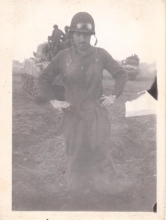
Watertown, NY
"My father, Rudolf Bachmeyer (right), was a German immigrant who came to the U.S. as a 5 year old with my grandparents. He grew up in Brooklyn, NY and was drafted into the Army in WW2 before he was even officially a U.S. citizen. Eventually he was assigned to the Heavy Weapons Platoon of Company A, 27th Armored Infantry Battalion, 9th Armored Division, and it was his Company that captured the famous Bridge at Remagen. He was among the very first to cross the bridge into Germany. My father’s name is listed in the back of the book, “The Bridge at Remagen”, but my father never talked much at all about his experiences during the war. He was honorably discharged from the Army in 1945 as a Sergeant.
My father died in 1992 in Glenville, NY, and in 1994, I attended the 50th anniversary of the capture of the bridge while I was also in the Army and stationed in Germany. While I was at the reunion, I showed his photo to many of the WW2 Veterans in attendance. No one recognized him until literally the last Vet who looked at it exclaimed, “Hey that was my Squad Leader!” That gentleman told me more about my father and what he did in WW2 than my father ever had.
Among the many stories he told me was that, since my father was a German immigrant and was fluent in German, he and his men were a little better well cared for than the others. “Because of your Dad, every German town or village we entered, the first thing we always found was the bakery, the butcher shop, and the girls.”
He also told me that as the Army liberated towns and villages in Germany, if the Mayor was a member of the Nazi party, he was removed from office by the Army and replaced by someone who was not. Apparently there was one instance where no replacement was available, so my father, again being fluent in German, was temporarily appointed mayor of a small village for a day or two until a suitable German citizen could be found.
I joined the Army in 1978, ten days after graduation from High School and made a career of it as a Military Policeman. I too am fluent in German as a result of my heritage, and additionally but unofficially 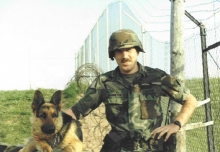 performed duties as translator and liaison to the German police while I was assigned to various Army Units in Germany for a total of 12 of my 20 years. I retired from the Army as a Staff Sergeant at Fort Drum in 2001, and immediately began working as a Deputy Sheriff in Jefferson County where I have been since.
performed duties as translator and liaison to the German police while I was assigned to various Army Units in Germany for a total of 12 of my 20 years. I retired from the Army as a Staff Sergeant at Fort Drum in 2001, and immediately began working as a Deputy Sheriff in Jefferson County where I have been since.
My son, Daniel Bachmeyer, now proudly serves our country as a Captain in the Air Force and is currently stationed in Virginia."
Sergeant First Class (RET) Darryl Sapoff
Gouverneur, NY
United States Army Jan 1985-Dec 2011
Platoon Sergeant
Haitatan City, Afghanistan, June 2010
"This was my 5th and final deployment."
Master Sergeant Michael Chevier
Calcium, NY
United States Army 1978-1998
 "I tell everyone I escaped Northern New York in 1978 and went on a world tour courtesy of Uncle Sam. Not bad for a young man who grew up in Gouverneur and could have went to work in either the mines or the paper mills. Looking back on it I do not regret the choice I made. I was a Military Policeman for the twenty years I was in. I am the tall one in the center of the picture. This picture was taken at South Camp in the Sinai, shortly after the Israeli's pulled out of the area. Three of these others in our desert BDUs were other soldiers in my squad and two were sailors from the Italian Navy. We were all attached to the 1/502 Infantry Battalion (First Strike) from Fort Campbell, KY. We were the second contingent in the Sinai with the Peace Keeping forces in 1982-1983."
"I tell everyone I escaped Northern New York in 1978 and went on a world tour courtesy of Uncle Sam. Not bad for a young man who grew up in Gouverneur and could have went to work in either the mines or the paper mills. Looking back on it I do not regret the choice I made. I was a Military Policeman for the twenty years I was in. I am the tall one in the center of the picture. This picture was taken at South Camp in the Sinai, shortly after the Israeli's pulled out of the area. Three of these others in our desert BDUs were other soldiers in my squad and two were sailors from the Italian Navy. We were all attached to the 1/502 Infantry Battalion (First Strike) from Fort Campbell, KY. We were the second contingent in the Sinai with the Peace Keeping forces in 1982-1983."
Captain Francis J. Monaco
Watertown, NY
United States Army 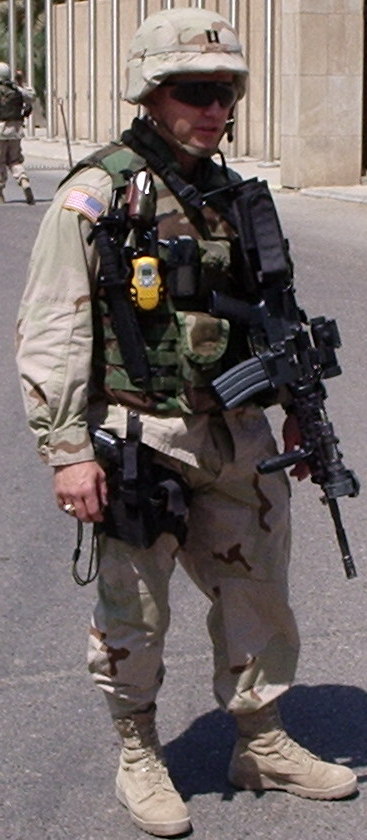
Commander, Headquarters Service Battery (HSB), 2nd Battalion, 82nd Field Artillery, 1st Calvary Division
Operation Iraqi Freedom 2004-2005
Baghdad, Iraq
Roland Van Deusen
Clayton, NY
United States Navy Reserve 1962-1972
"I want to remind my fellow veterans that we all know someone who knows someone with PTSD. My two minute video below encourages troubled vets to seek help."
May 15, 1962: Enlisted in US Naval Reserve age 17, Junior year Watertown High School.
Spring 1963: won use-or-lose academic scholarship paying most of tuition at Syracuse University, extended enlistment four years to get education.
Summer 1963: On training cruise aboard USS John Hood DD-655, almost killed when wave broke over bow, threw me 20 feet sideways and almost overboard.
Summer 1964: Gulf of Tonkin Resolution put US in full scale war in Vietnam.
Spring 1967: Failed eye exam for Officer Candidate School.
July 1967: Reported for active duty Brooklyn Navy Yard, requested River Patrol Boats in Vietnam, ordered to Naval Air Station Keflavik Iceland, which intercepted and tracked more Soviet aircraft and submarines during Cold War than any other US facility.
Late 1967: Again requested transfer to River Patrol Boats in Vietnam, again denied (likely reason - poor eyesight).
Summer-Fall 1968: Aboard USS Alstede AF-48, Atlantic and Mediterranean cruise, re-supplying Sixth Fleet. Crew told that due to annual live gas drills aboard harassing Soviet warships, we were to have our gas masks with us at all times.
Late 1968: Release from active duty.
May 14, 1972: Honorable Discharge after ten years total active and reserve service.
Corporal Seamus MacLean Davey
Lowville, NY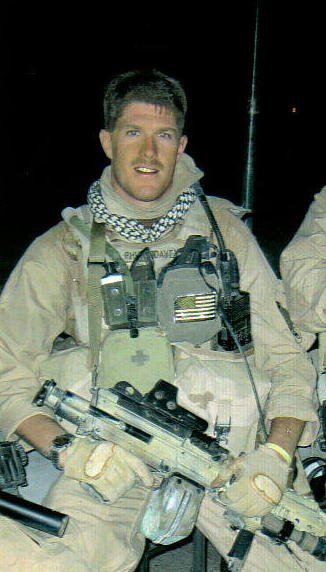
United States Marine Corps
Member of 2nd Force Recon, 2nd Marine Division
Killed in Action, Albu Hyatt Iraq, October 21, 2005
Awarded Bronze Star for Valor (posthumously)
Cpl. Davey’s team was tasked with removing insurgents from the Euphrates River valley. Upon entering a room in a house on the river on the morning of Friday, October 21, 2005, his team encountered 4 military aged men with automatic weapons. All three Marines in the team were hit with rifle fire. Cpl. Davey remained in the room and returned fire allowing the two injured Marines to escape. Cpl. Davey received mortal wounds. He is dearly missed by his extended loving family and the Marines that he served with.
Potsdam, NY
United States Army Reserve
Upon earning a Bachelor’s Degree in 1969 from the University of Missouri, long-time resident of Potsdam NY (St. Lawrence County), Thomas C. Young, accepted a commission in the US Army Reserve as a Second Lieutenant of Infantry. Lieutenant Young’s two year active duty commitment began with the Infantry Officer Basic Course at Ft. Benning, GA. Lieutenant Young’s next duty station was Ft Riley, KS where he served as a rifle platoon leader and company executive officer in 2/21 INF, 24th Infantry Division (the unit was re-flagged as the 1/2 INF, 1st Infantry Division, during the period of Lieutenant Young’s Ft. Riley assignment).
In June 1970, Lieutenant Young received orders for deployment to Vietnam and was assigned to ADV TM 55, U.S. Military Assistance Command, Vietnam (MACV). While with MACV, Tom Young received promotion to First Lieutenant and served as
a Mobile Advisory Team member (MAT) and leader to advise company and battalion-sized units of regional (RF) and popular forces (PF) during training and combat operations in Kien Giang Province, which is located on the west coast of the Mekong Delta and abuts the Cambodian border and the Gulf of Thailand. Lieutenant Young was Honorably Discharged from active duty in June 1971.
Honors and Awards earned by Lieutenant Young for his service in the US Army include: the Combat Infantryman’s Badge, the Bronze Star Medal, the Vietnam Service Medal, and National Defense Service Medal (from DoD/US Army); Vietnam Campaign Medal, Vietnam Training Service-First Class (from Republic of Vietnam); Conspicuous Service Cross (from State of New York).
Sgt. Norman J. Edwards - United States Army
Petty Officer G. Milton Edwards - United States Navy
Granville, NY
"I always thought this was a nice "hometown" write up. It was my dad and uncle enlisting with pride to serve their country" - Kathleen Terrio
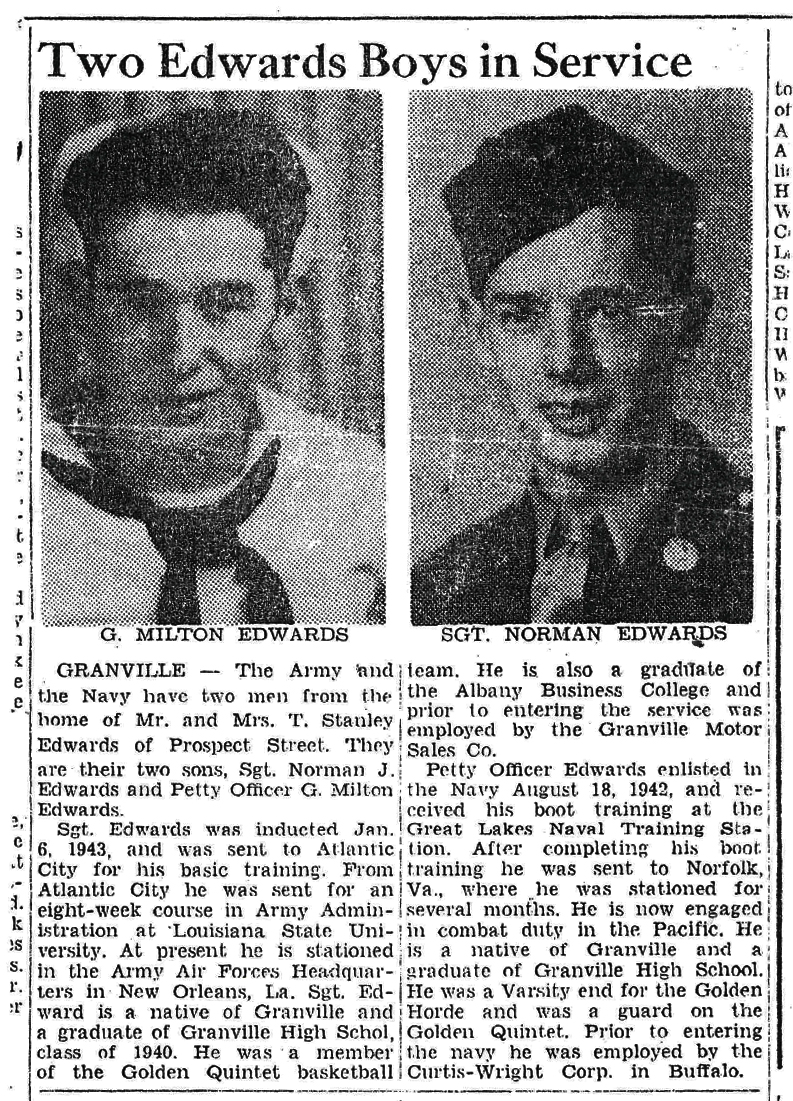
Renald John Devine
Hudson Falls, NY
United States Marine Corps
"Here is a picture of 3 generations of U.S. Marines “OORAH”. My Dad on the far left was on Guadalcanal when he was 17 years old. I am in the center. My unit was 3 BLT 8th Marines Fleet Marine Force. I deployed with the 6th fleet from late 1970 to early 1971. My son is on the far right. He deployed for a limited time during the 1st Gulf War to Kuwait and then went on to Japan after about a year later."
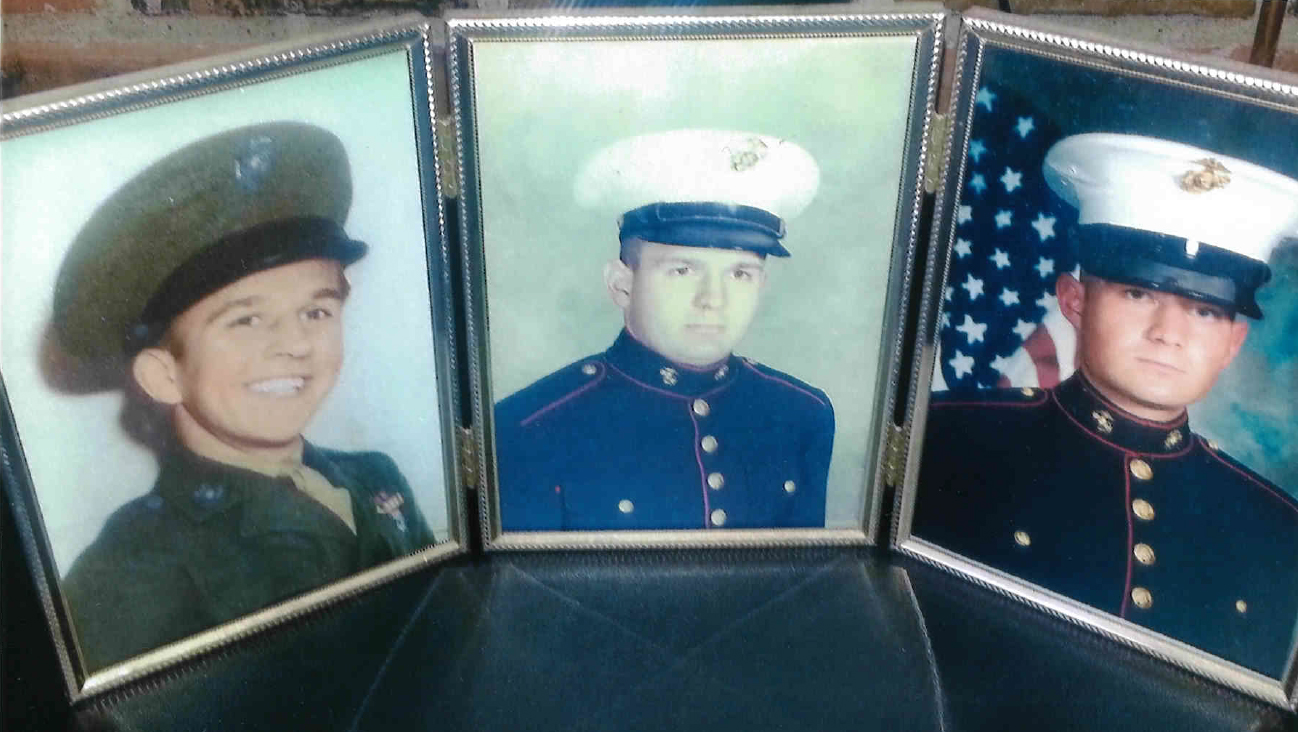
My Dad (left) – Renald Gene Devine
Myself (center) – Renald John Devine
My son(right) – Renald Brett Devine
Staff Sergeant George A. Peterson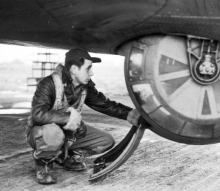
Norwood, NY
"I am submitting an article concerning my wife's uncle who served during World War ll in the Army Air Force. This article was originally published many, many years ago in the Watertown Daily Times. In the crew picture George is the second one in the bottom row kneeling."
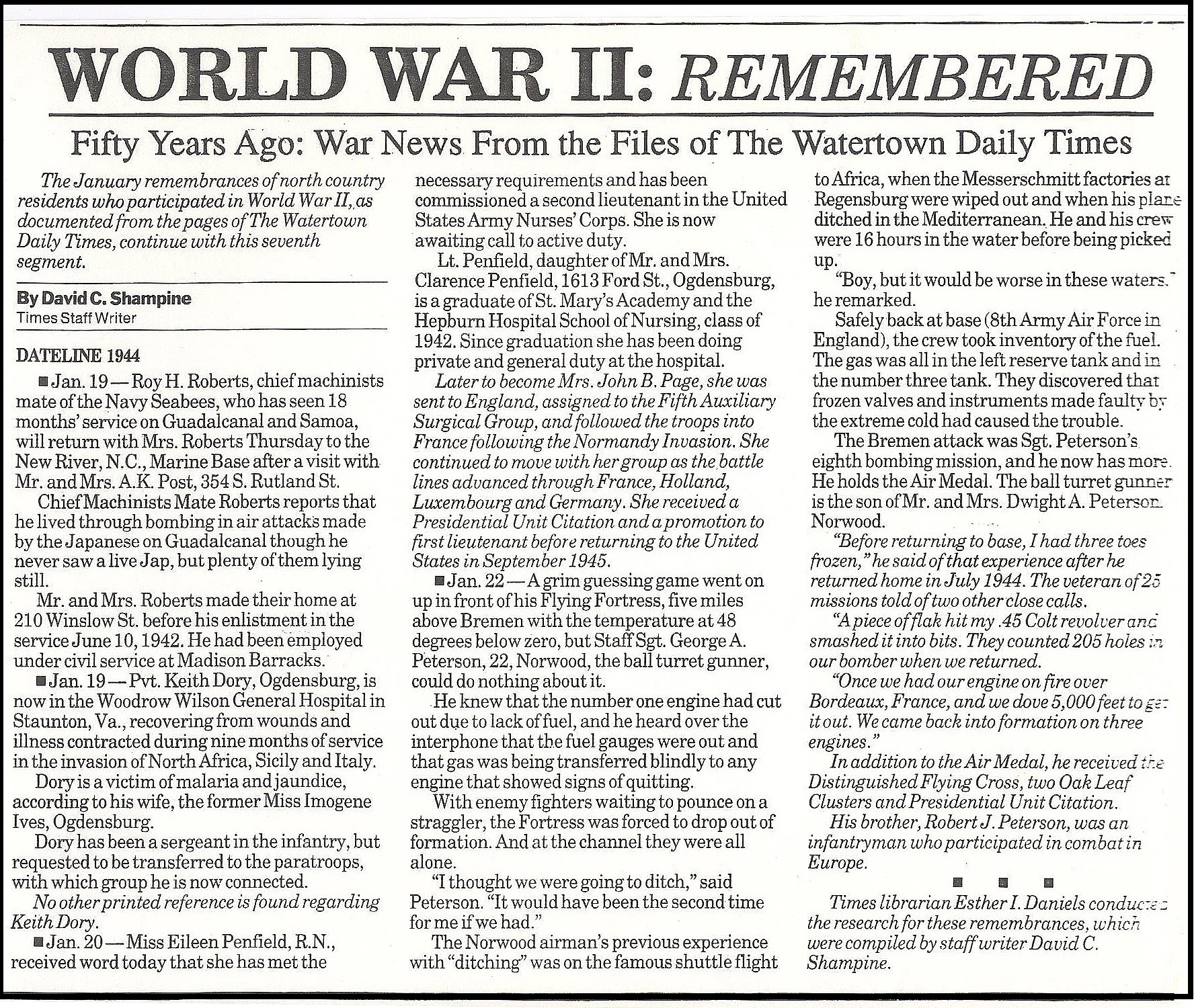
Staff Sargent William “Bill” Spriggs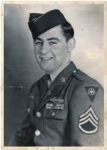
United States Army
Ogdensburg, NY
"Born November 1925 in Ogdensburg, NY, his early years were spent during the Great Depression. He learned at an early age to work hard and manage with little, especially during the cold winters of the North Country.
He joined the Army on March 2, 1943 at the age of 17, and received his training at Fort McLellan. He shipped to England from New York in June 1944. In early July 1944, they landed at Omaha Beach and he began 244 days in combat with the 83rd Infantry. The five battle stars earned were for combat in Normandy, Ardennes, Central Europe, Northern France, and Rhineland. He was awarded two bronze stars, and a purple heart for wounds received in France. However, his most prized medal is the Combat Infantryman’s Badge. When the war ended, he was in a foxhole in Zerbst, Germany, on the Elbe River. He attributes his survival during the war to his experiences as a young man growing up in the North Country when winters were harsh, and food and clothing were limited. This was especially important to withstand the brutal conditions during the Huertgen Forest and Battle of the Bulge.
He returned from Europe in November 1945, receiving an honorable discharge. Because he had quit school in the 10th grade, he then worked second shift in a factory so as to attend high school and get his degree. In 1952, he moved to Massena, NY, and later retired from the St. Lawrence Seaway, but not before he earned a Master’s Degree from Syracuse University.
On May 9, 2014, he was awarded the Insignia of Chevalier in the National Order of the French Legion of Honor at a ceremony in West Point, NY.
In the past years, he has participated in WWII memorial walks and celebrations in Belgium, France, and Germany. He has spoken to children in schools there, who all have questions about his experience. He considers it his duty to be an ambassador to promote camaraderie between our countries since they have such a high regard for our WWII veterans. He has been humbled by the European’s gratitude and appreciation for his service, and has made lifelong friendships in the process. He is always happy to speak of his wartime experiences to anyone who is interested and says he remembers them just like they happened yesterday."
Don Wharton
United States Marine Corps
South Glens Falls
THE PATROL
"Our Big Sea Knight chopper lifted off from Dong Ha below the DMZ and headed north. This was concerning to me since I knew the operation we were going in on was off to the west.
I was seated across from the door gunner with his big .50 caliber machine gun and as I looked down past the barrel all I could see was unbroken green jungle. It looked like the mountains I’d flown over on hunting and fishing trips in the Adirondacks but this was jungle, not forest. I checked on the guys in the back of the chopper and I could see they weren’t happy campers. No doubt they were thinking about our chopper that had been shot down the day before. It was 4,000 feet down to the ground below.
We’d flown far enough north for me to know that if we weren’t over North Viet Nam we were very close to it. This was one of those 4 or 5 times in Viet Nam when I had my doubts about us coming back in one piece. Being one of the first Marines to make a landing north of the border was not something that I’d looked forward to or even expected. The south was bad enough.
Suddenly our flight of choppers did a U-turn and headed back to the southwest. In a few minutes we were landing near the 700-foot high Rock Pile in a field that was still smoldering from an artillery strike a few minutes earlier. When we landed I realized that the maneuver with the choppers had been an attempt to get the enemy to come up on the radio so we could locate him. I’d seen this tactic used in ground operations farther south around Phu Bai and Hue.
We’d flown into the Rock Pile area as part of Operation Hastings in mid-July of 1966. The operation was launched to counter the invasion of northern Quang Tri province by the 324-B North Vietnamese division. Marine Recon had located them in early July and our Two/One battalion was part of a 5 - battalion Marine task forced moved north.
Around noon on the first day I happened to be standing near the colonel when he called in an air strike on an enemy machinegun position about a half-mile away. In a couple minutes a Marine F-4 Phantom swooped in with its 20MM cannon. That night our command post got mortared with the shells shaking the ground. Marines quickly got busy with their entrenching tools digging deeper, including myself. I was one of the few that had an e-tool with a pick on it.
Late in the evening a couple days later we got word that we’d be running a patrol on a trail running north from the Rock Pile with the purpose of establishing a blocking position off to the north. It was the dark of the moon and I thought for sure that someone could be left behind. The order came down for “no fixed bayonets” which I was not happy with, but I soon found out that with bayonets attached in the dark we’d constantly be spearing the guy in front with our jungle slings. Sometimes it was necessary to touch the guy in front of us to make sure we were still on the trail.
Progress up the trail was slow and about midnight there were a flurry of shots back down the trail. We learned shortly over the radio that two Marines had been killed, including the company XO, and one wounded in an ambush.
After the ambush our patrol had split at a point three guys behind me and we were forced to wait while the guys in the rear caught up. I didn’t recognize the voices of the three guys behind me and asked in a low voice who they were. One of them told me they were two forward air controllers (pilots) and a corpsman.
Suddenly there were sounds of someone running on the trail behind us. When they were about to collide with us one of the guys challenged them with the standard - procedure “Who goes there?” That was followed instantly by a two-word shout in Vietnamese and blasts from automatic weapons. I got sprayed from head to toe with broken rock and gravel as I dove off the trail. It felt like I’d been hit with a load of bird shot.
When I landed I landed on someone or something. Not knowing if it was a Marine or an NVA I jammed my rifle into the back of his head and asked who it was. He was none too fast in answering up. The three guys behind me were dead when they hit the ground. I’d been prepared to shoot but couldn’t because they were in the way. Our machinegunner a couple people up from me hammered the jungle as the enemy ran up a streambed next to the trail but the splashing continued. Our artillery at the Rock Pile registered their guns on the ridge above us in case the NVA tried something else.
I give the enemy soldiers credit – they were good and undoubtedly special forces of some type. They were shooting something other than AK-47s, another indication of special troops.
At first light we placed the casualties in ponchos, lashed them to poles and carried them forward to where they could be lifted out by chopper. One more Marine, a sergeant, was killed by a sniper firing from a spider trap just as we reached our blocking position.
A few days later on our way back down to the Rock Pile we passed another of our companies on that same trail with all of them carrying Chinese AK-47s. There wasn’t a sound as 200 men passed in the jungle. Those guys were hardened combat veterans. Along the trail were dozens of freshly dug NVA foxholes to protect traveling troops from Marine air and artillery.
The enemy got the best of us on that trail that night but in the end we’d settle the score. When he headed back north across the Ben Hai River a couple weeks later he was looking for replacements for some 2,000 men killed in combat below the DMZ. 126 Marines were killed and 400 wounded. I wrote an article for VIETNAM magazine and heard from two of those wounded Marines from Texas.
When our chopper lifted off from Route 9 near the Rock Pile I looked down and saw a lot of big fish floating down the river below killed by bombs and artillery. A few days earlier we’d waded that river.
When our boat docked in San Diego a couple months later we were greeted by a large celebration involving speeches and a band, but that was the last celebration we’d see for a long time."
Captain Robert Hicks
United States Army
Granville, NY
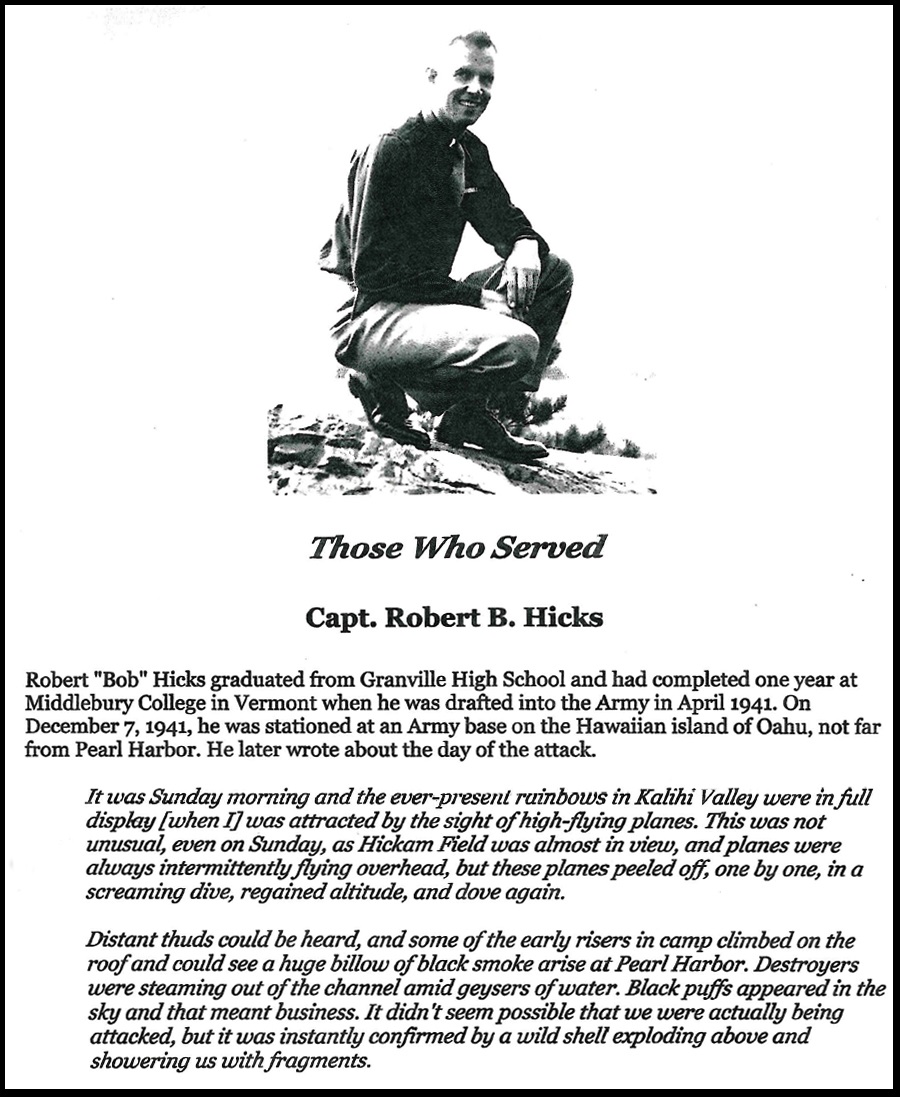
Major Lee Brooks
United States Army
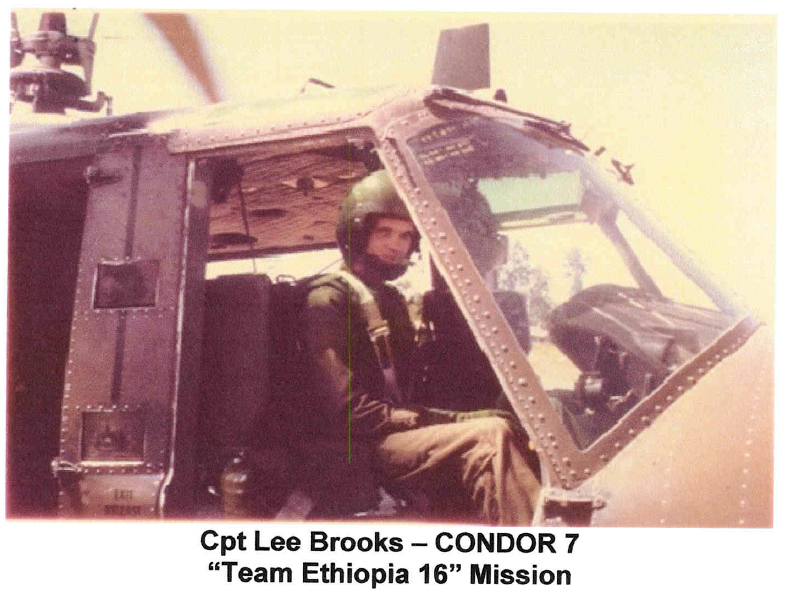
Robert Noody
Star Lake, NY
"Bob jumped into St. Mere Eglise (Normandy) with the 101st Airborne landing in the Mayors backyard. He has returned to France and has received multiple medals from the French government in addition to two Bronze Stars, two Purple Hearts and all the campaign medals that involve the Atlantic Theater. Bob met Congresswoman Stefanik at the Tomb of the Unknown Soldier on the North Country Honor Flight on May 16th, 2015.
He was a member of F Company, the fighting flank of E Company (The Band of Brothers) written about in "The Fighting Fox Company". See Bob holding his Bazooka he jumped in with at 3 AM on D-Day. This quiet Hero never talked about his service to his country until the book by Terry Poyser and Bill Brown came out. Bob has been interviewed several times including coverage at the 75th anniversary of D-Day in Normandy." - Dave L., North Country Honor Flight Guardian
Gerald Cashion
United States Air Force
Glens Falls, NY
My name is Gerald Cashion, and this is the story of my service to my country. In 1959, I was drafted to go into the Army. I had a month to look around and possibly find something more appealing, as the Vietnam crisis was looming and I didn't think that would be the best choice for me at the time. Luckily, I found out about an opening in the Air Force Bagpipe Band, a segment of the Air Force Band, located at Bolling AFB in Washington, DC. I hopped on a bus and journeyed to DC to take an audition, as I already played the bagpipes and it sounded much better than Vietnam.
I passed the audition, joined the band after basic training in Texas and began marching and playing with the band for various functions throughout the US.
About that time, John F. Kennedy was elected president and he sort of adopted our band as "his" band, and soon we were playing for Easter egg rolls, airports and buildings that were dedicated by the President.
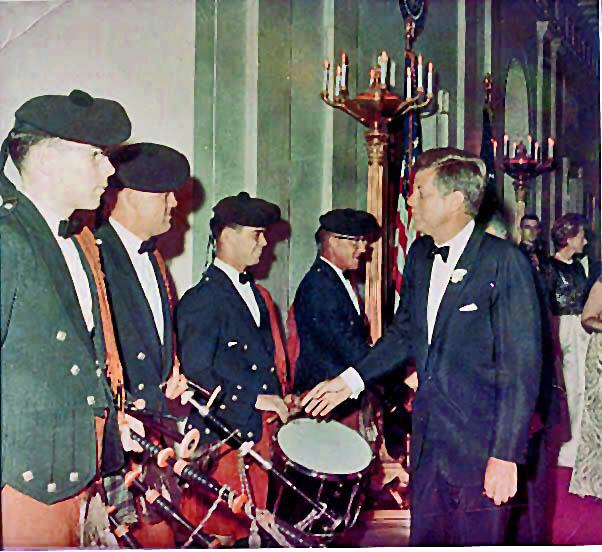
On October 15, 1963, I was chosen to play at the Whitehouse for a dinner for the Prime Minister of Ireland, attired in special Irish uniforms, rented especially for the occasion. My job was to pipe in the Baked Alaska for the guests. The following month, JFK was assassinated in Dallas, Texas, and Mrs Kennedy requested our band to play at the graveside in Arlington, VA.
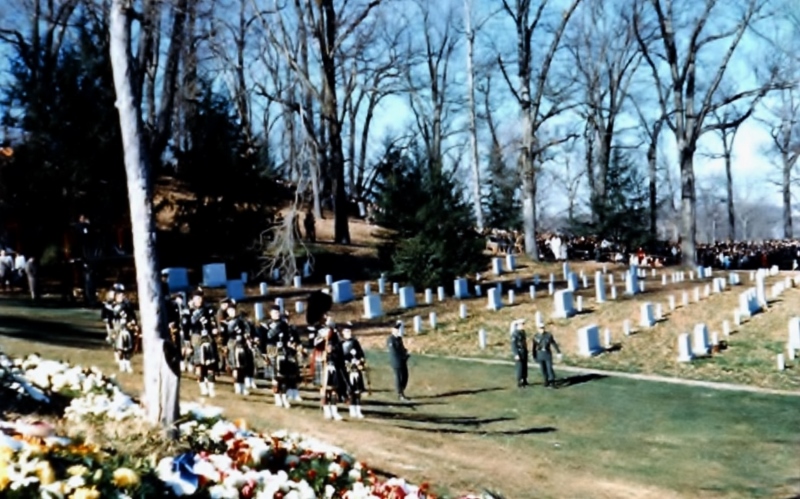
Although this was the most memorable event in my military stint, I participated in many important functions throughout my four years as an Air Force bagpiper. Upon leaving the service, I enrolled in college, completed my BS in 3 1/2 years and began teaching at my former high school in Glens Falls, NY.
James Thackaberry
United States Army
Johnsburg, NY
 I spent almost 30 years as an operator in the U.S. Army Special Forces (Green Berets), enlisting in 1971. I started as a Communications Sergeant, later cross training in Demolitions and Intelligence. Eventually I became a Team Sergeant as a Master Sergeant. I participated in many operations throughout South and Central America in the various conflicts there. While converting briefly to Reserve status, I got a BS degree from SUNY College of Environmental Science and Forestry and Syracuse University. After that I returned to active duty. Eventually I became a Special Forces Warrant Officer and was either the Executive Officer on A-Detachments, or the Team Leader. My last combat tour was in Afghanistan in 2002. I retired in late 2003 and continued much of the same work as a Gov’t contractor. I retired with my wife to our property in Johnsburg, NY.
I spent almost 30 years as an operator in the U.S. Army Special Forces (Green Berets), enlisting in 1971. I started as a Communications Sergeant, later cross training in Demolitions and Intelligence. Eventually I became a Team Sergeant as a Master Sergeant. I participated in many operations throughout South and Central America in the various conflicts there. While converting briefly to Reserve status, I got a BS degree from SUNY College of Environmental Science and Forestry and Syracuse University. After that I returned to active duty. Eventually I became a Special Forces Warrant Officer and was either the Executive Officer on A-Detachments, or the Team Leader. My last combat tour was in Afghanistan in 2002. I retired in late 2003 and continued much of the same work as a Gov’t contractor. I retired with my wife to our property in Johnsburg, NY.
Warren L. Schermerhorn
Lake George, NY
My father, Warren L. Schermerhorn served in WWII. He was a member of "The First Special Service Force", AKA "The Devil's Brigade". He served in the European Theater for 3 years, and was with The FSSF for 2 of those years. During his service, "The Force", as it was called, performed many special operations missions, while attached to various larger contingents. 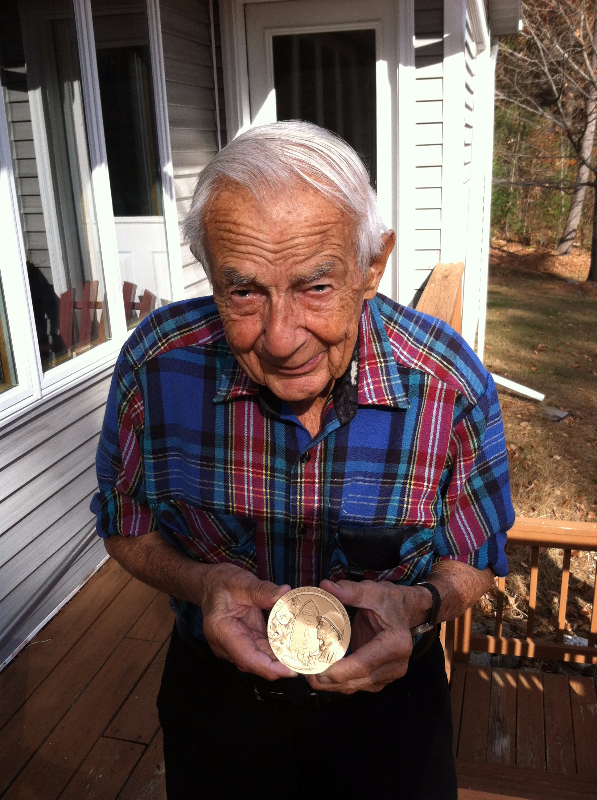
Under the direct of then Colonel (later General) Fredricks, they were responsible for the assault on Mount la Definsa. This operation freed the Allied forces from the beach head at Anzio, Italy, where they had been pinned down for months. With the German forces no longer in control of this fortress, the way to Rome was now open to the Allies. My father said that he was among the first troops to enter the city of Rome.
As a side note, my father shot down a Messerschmidt with a 50 caliber machine gun mounted on a truck; as he and 2 other soldiers were on the way to the shore to get supplies. He said he knew it was headed in to "take out our guys" so he climbed on the roof of the 6X6 truck where the gun was mounted and took the shots that brought down the plane. I really can't think of anyone else I know who has shot down a war plane.
Later in the campaign, members of the The Force were among the first troops to liberate the death camp at Buchenwald, in Germany. The stories my father told me of that horrible place really were difficult for him to recount.
He spoke often, mostly in his later years, about the friends he made and lost while with The Force. To him, those friendships were more important than any of the battles he was in. His stories are far to numerous to mention here, but I think the important thing is that at least some of these stories are recounted and written down for future generations to hear. His was certainly, in my mind "the greatest generation" and their service in the wars of that era is one that should not be forgotten.
My father spent most of his adult life in Lake George, NY along with my mother as the owners of a family resort in Lake George. He passed away in November of 2015 at the age of 92, just 2 months after my mother. They were together for over 70 years.
I have also attached a picture of my father just a few weeks before he passed. He is holding a bronze reproduction of the Congressional Gold Medal awarded to The First Special Service Force as a unit. Each living member of The Force received one of these medals. I know this was one of the proudest moments of his entire life. When he saw the medal, he broke down in tears. When I asked him why, he said it made him think of all of "his buddies" that did not make it back from the War.
I would like to thank Congresswoman Stefanik once again for her help in procuring this medal for my father.
Larry Gray
Lake George, NY
I was born in 1946 and served during the Vietnam War. I thought it was wonderful to serve this country even though I was drafted. I still feel today that everyone that is in this country should serve in the military. It brought unification and Camaraderie amongst those who served together. This is something the country really needs amongst everyone. I learned never to judge anyone by race and that everyone must be treated equal.
When I was 16 years old I started working in a manufacturing company named Web Graphics Inc. locally in Glens Falls New York. It was a small company with two employees when it started in 1965. With that start up Business I fell in love with the manufacturing products in the USA.
As soon as I graduated from high school at 18 years old I was drafted into the US military to serve in the army. Whenever I returned on leave from the military I worked in the Company.
After leaving the military I continued in manufacturing. By 1980 I was the executive Vice President and general manager of An 300+ employee company. I had built a house on Lake George New York in which I resided with my family and youngest son Adam. The company I was employed by was purchased by a fortune 500 company in 1982. By early 1983 I had made a decision to go into my own business to continue manufacturing products here in the US.
Seargent First Class Curtis Banker
Peasleeville, NY
LUZON, PHILIPPINE ISLANDS, Jan. 9th, 1945:
The Navy Underwater demolitions crew, “Frog Men”, had been working to clear all obstacles and defuse any mines that would hold up the assault of the beach landing. Dawn was approaching and “H Hour”. Suddenly I saw a small bonfire on the left beach and then one on the right beach. This marked the landing area and also signaled that the area had been cleared of all obstacles. The LST’s started unloading LVT-4s off the ramp into the water. Smaller boats, all filled with Infantry, assembled in circles, then they formed a line, and headed toward the beach. Navy guns were shelling the beach with the largest weapons. The earth seemed to shake from the concussion. The sky was filled with tracers. A small boat was laying a smoke screen, hiding the first wave, which disappeared from view in the smoke. The second and third waves were close behind the first. We were in the fourth wave and started toward the beach. A 300 mm Artillery gun, that the enemy had placed in a cave on a mountain to our left front started to fire on the beach. One round hit the landing craft to our left in the front gun turret. An enemy aircraft had crashed to our right on the beach.
Suddenly our landing Ship became stuck, on a sand bar, near shore. Our Officer had the crew lower the ramp, then he jumped off the ramp, with his hand over his head, to measure the water depth. All we could see was his hand above the water. Crawling back on the ramp he said we could unload the M-7 in front to lighten the load. We mounted up and drove our M-7 off the ramp. The tank, half floating, was pushed to shore by a large wave. The landing ship backed off and tried again to get closer to the beach, which it did. The large Enemy gun was still firing at the navy boats. Infantry troops had moved inland securing the village of San Fabian. We dismounted while our Tank crossed a small river on a Railroad Bridge. Then we secured our assigned area near the village, prepared a defense and remained there all day and that night.
Our 5 LVT-A-4s, that were in the first wave, with rifle Companies, remained with them. We lost one, to enemy fire, the one I was assigned to in New Guinea. Corporal Alvin Isaachsen and Leo Sperdutti were killed in that amphibious tank. That night an enemy placed a grenade on the track of an M-7, to knock it out, but it was found and disposed of. Bulldozers started digging the graves, to bury the dead ,near our position.
The next day we moved closer to the front in support of the rifle Companies which had advanced inland toward San Jacinto. A dry river bed was covered with dead enemy, horses and enemy artillery. It was hit with Navy, or our artillery, fire. The smell of decaying bodies was terrible. We ran over some of the dead to continue on. Our tank smelled terrible for days. The horses and human bodies had swollen, from the hot sun, would pop like a balloon. There was no way to get around them. What a horrible sight.
We advanced to the village of Pozarubio which was already destroyed from fighting. We were in a firing position for a few days providing support for our troops as well as harassing fire at night. We got some return fire from the enemy artillery which we named “Pistol Pete”. One M-7 was knocked out, on a direct fire mission, and the section chief, Sgt. Terracina was killed.
Hill 200 was well defended and the source of fire we had received, on the beach, from a large gun. Our Tank was called on to support a rifle Company that was pinned down by enemy fire on that hill. We were briefed and moved to about 100 yards from a cave where the fire was coming from. Seeing our large tank caused them to fire at us .I was loading the gun, so when I raised up above the armor plate to load, I was exposed from the waist up. I loaded a white Phosphorus, smoke, round and we fired into the cave opening. The enemy fire stopped. I then loaded a high explosive round and as the projectile left the gun a lone enemy came out of the cave and received the full blast of the shell burst. I saw his leg and boot fly into the air, a sight I have never forgotten. I had blood shooting up my arm, from my glove as I loaded the last round. Two of my fingers, on the right hand, were nearly cut off, just below the first joint.
As soon as I could, I saw a medical aid man and was examined by a Doctor. He sewed my fingers back on and sent me back to duty. I have a Purple Heart that is on my service records. We fought in the hills, going toward Baguio, for 38 consecutive days. The 103rd Inf. Regt. had 172 dead and 551 wounded in action. Enemy casualties were estimated at 10 times as many. The fighting was heavy at times.
Hugh Sonner
Corinth, NY
My ancestor Phillip Sonner came from Germany in 1756 at 21 years old. When the American Revolution came, he joined the American Army as a soldier and a spy for George Washington. German soldiers were mercenaries who fought for the British in the Revolution. Sonner would peddle food to the German soldiers and collect the information for Washington.
In WWII as a soldier I went to a town called Sonnerdorf on the boarder of Austria, Phillip Sonner’s hometown.
In WWII I spent 10 months on the Western Front in the 3rd US Army made all the major battles-Went to Europe on the USS Brazil A 2 Stalker with 5 other soldiers. We landed in Glasgow Scotland, our navy chased off German submarines who were trying to torpedo our ship. We went to Wales, got our weapons and live ammunition, left Southampton, England, 3 AM in the morning, women were crying, landed on Utah Beach--only 200 of us died there. On Omaha Beach--thousands died. Above Omaha is Coleville cemetery where 10 thousand lie in honored glory. Several of my comrades are buried there--20 years ago I went back, tears came to my eyes.
60 Million died in WWII, war is terrible to experience. But there will always be wars.
--Hugh Sonner
3rd Army, 4th Armored Division
Helyn Stowe
Theresa, NY
I chose to enlist in the Army for many reasons. I am very proud and honored to have had the opportunity to serve with, lead, educate our nation’s sustainment force. I served in Germany when the Berlin Wall came down. Desert Storm when we liberated Kuwait. Serving in Afghanistan and Iraq was by far the most life changing experience in my 15-year career.
 Early on in my career, I became a victim of Military Sexual Trauma. This is the toughest part of my story to tell for obvious reasons. It is something I buried deep down inside for decades now.
Early on in my career, I became a victim of Military Sexual Trauma. This is the toughest part of my story to tell for obvious reasons. It is something I buried deep down inside for decades now.
While leading a team, we came under heavy fire. During this incident I became injured by a blast. The resulting traumatic brain injury (TBI) has made a permanent mark on every aspect of my life. I experience major headaches, loss of balance, worst vertigo and vomiting I could ever imagine, and all of this takes its toll in conjunction with PTSD. The fear of leaving the house to go to the store of fear. Fear because a suicide bomber walked past my position and detonated I have felt as if I had no control over my life and even contemplated ending my suffering permanently. I struggle continually to talk about myself and my experiences out of fear for many reasons. Fear of being alone and a burden to others is a dichotomy I struggle with.
Astro [my servcie dog] is my medic, my companion, my lifeline. 
Now that I have been retired from the Army, with Astro’s help, I am a successful entrepreneur. I am the owner of a livestock farm – Indian River Farm. Because of Astro, I can go shopping whenever I want, attend livestock auctions, farmer’s markets, network with other farmers and clients. I am able to get the medical and psychological care with him helping me up when I fall, literally. I can’t imagine my life being so successful without him!



